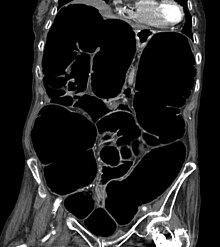Ogilvie syndrome
| Ogilvie syndrome | |
|---|---|
| Other names | Acute colonic pseudo-obstruction |
 | |
| CT-Scan showing a coronal section of the abdomen of an elderly woman with Ogilvie syndrome | |
| Specialty | Gastroenterology |
Ogilvie syndrome, or acute colonic pseudo-obstruction is the acute dilatation of the colon in the absence of any mechanical obstruction in severely ill patients.[1]
Acute colonic pseudo-obstruction is characterized by massive dilatation of the cecum (diameter > 10 cm) and right colon on abdominal X-ray.[2][3] It is a type of megacolon, sometimes referred to as "acute megacolon," to distinguish it from toxic megacolon.
The condition carries the name of the British surgeon Sir William Heneage Ogilvie (1887–1971), who first reported it in 1948.[4][5][6]
Ogilvie syndrome is an acute illness, which means it occurs suddenly and temporarily, and it only affects your colon. "Intestinal pseudo-obstruction" is a broad term that refers to any paralysis of the intestines that is not caused by a mechanical obstruction. Some individuals develop chronic intestinal pseudo-obstruction as a result of a chronic disease or a congenital condition.[7]
Signs and symptoms
Usually the patient has
Cause
Ogilvie syndrome may occur after surgery, especially following
Pathophysiology
The exact mechanism is not known. The probable explanation is imbalance in the regulation of colonic motor activity by the
Acute megacolon develops because of abnormal
Acute megacolon can also lead to
where T is wall tension, P is pressure, r is the radius, and t is wall thickness. Since the wall tension is proportionate to the radius, a dilated intestinal segment has a greater wall tension than a nondilated segment; if the dilatation and tension are sufficiently great, blood flow may be obstructed and ischemia of the bowel will occur.[12] Ogilivie syndrome may precipitate volvulus.[citation needed]
Diagnosis
Diagnosis starts with physical exam, observation, and interview of the patient. Imaging to diagnose dilation of the colon involves one view abdominal xray or obstruction series (PA chest, erect abdomen, and supine abdomen images). If further imaging is needed CT may be ordered.[13]
Treatment
It usually resolves with conservative therapy
Prognosis
Ogilvie syndrome is a serious medical disorder. Its mortality rate can be as high as 30%.[8] The high rate is likely a measure that this syndrome is seen in critically ill patients, rather than this syndrome being in itself lethal, although it can also present in otherwise healthy individuals (especially if the disorder was induced by pharmacologic agents). Drug-induced megacolon (such as from clozapine) has been associated with mortality as high as 27.5%.[12]
References
- ^ PMID 10403850.
- ^ ISBN 978-0-7216-8973-9.
- ^ PMID 10806132.
- S2CID 68079923.
- Who Named It?
- .
- ^ Cleveland Clinic medical professional (2023-03-08). "What Is Ogilvie Syndrome (Acute Colonic Pseudo-Obstruction)?". Cleveland Clinic. Retrieved 2024-04-15.
- ^ ISBN 0-7817-3548-3. Archived from the original on 2005-11-07.)
{{cite book}}:|website=ignored (help - ^ Skeik N, Jabr FI (2009). "Ogilvie Syndrome". Consultant. 49 (2).
- PMID 10843364.
- PMID 23217613.
- ^ PMID 19812406.
- PMID 30252358.

